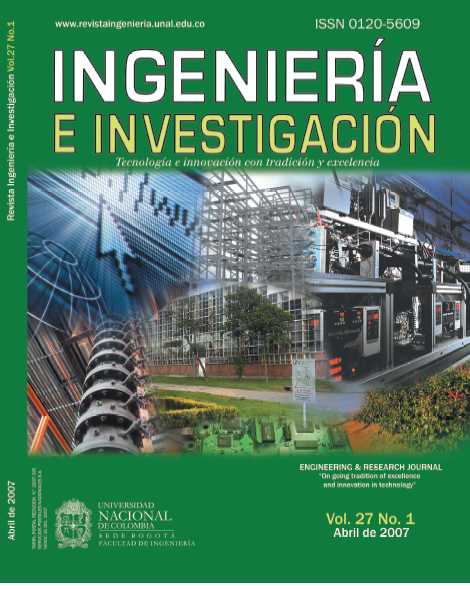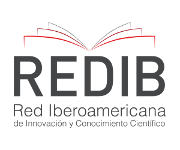Synthesis and characterisation of simultaneous interpenetrating polymer networks (SIN) formed by polystyrene and polyurethane obtained from castor oil and cassava starch polyol-suspensions
Síntesis y caracterización de redes poliméricas simultáneamente interpenetradas (SINs) formadas por poliestireno y poliuretano obtenido a partir de poliol-suspensiones de aceite de higuerilla y almidón de yuca
DOI:
https://doi.org/10.15446/ing.investig.v27n1.14780Keywords:
trans-esterified castor oil, cassava starch, polyurethane/ polystyrene SIN (en)aceite de higuerilla transesterificado, almidón de yuca, SIN poliuretano/ poliestireno (es)
Downloads
Castor oil was modified by transesteritication with pentaerythritol and cassava starch was subsequently incorporated into this oil (oil modified by incorporating starch is called a polyol-suspension). Polyurethane/polystyrene SINs (simultaneously produced IPNs) were synthesized from them and styrene. Reactants used in the synthesis were MDI (methylene diphenyl diisocyanate) as diisocyanate, DVB (divinylbenzene) as crosslinking agent for polystyrene, dibutylamine as redox primer and benzoyl peroxide as styrene polymerisation primer. The variables considered in SIN synthesis were percentage weight ratio used in the modification (1.32%; 2.64% and 5.28%) to increase polyol hydroxyl functionality, starch species incorporated into polyol (Brazilian, Venezuelan and commercial) to vary the amount of amylopectin within the polyol-suspension, diisocyanate/hydroxyl NCO/OH (0.85 and 1) functional groups’ molar ratio and polyurethane/ polystyrene PU/PS weight ratio (70/30 and 80/20). A wide range of materials was obtained and characterised by tensile strength, hardness, chemical attack and Soxhlet extraction. The physical-mechanical properties of the materials produced with polyols (transesterified castor oil) were improved when starch was incorporated into the polyol. Several tests indicated that 24 hours as curing time were not enough, because the SINs showed lower physical-mechanical properties than the homologous polyurethane elastomers did; thus, the curing time had to be increased to 48 hours.
Se llevó a cabo una modificación del aceite de higuerilla mediante transesterificación con pentaeritritol y posteriormente una incorporación de almidón de yuca al aceite modificado, obteniéndose las denominadas poliolsuspensiones. A partir de estos y de estireno, se sintetizaron SIN poliuretano/poliestireno (IPN obtenidos mediante vía simultánea), utilizando metilendifenil di-isocianato (MDI) para formar la red de poliuretano, divinilbenceno (DVB) como agente entrecruzante del poliestireno, dibutilamina como iniciador redox y peróxido de benzoilo como iniciador de la polimerización del estireno. Las variables consideradas en la síntesis de los SIN fueron: relación másica porcentual pentaeritritol/aceite empleada en la modificación (1 ,32%; 2,64% y 5,28%), con el fin de variar la funcionalidad hidroxílica del poliol; especie de almidón incorporado al poliol (brasilero, venezolano y comercial}, con el objeto de variar el contenido de amilopectina en la poliol-suspensión; relación molar de los grupos funcionales diisocianato/hidroxilo NCO/OH (0.85 y 1) y relación másica poliuretano/poliestireno PU/PS (70/30 y 80/20). Se obtuvo una amplia gama de materiales, caracterizadas con pruebas de resistencia a la tensión, dureza, ataque químico y extracción Soxhlet; las propiedades físico-mecánicas de los materiales producidos a partir de los polioles (aceite de higuerilla modificado) se incrementaron con la incorporación del almidón a estos. Respecto al tiempo de curado, se observó en diferentes pruebas realizadas que 24 horas son insuficientes, dado que los SIN mostraron propiedades fisico-mecánicas inferiores a los elastómeros de poliuretano homólogos, siendo por tanto necesario aumentar el tiempo de curado a 48 horas.
References
Athawale, E. and Kolekar, S., Interpenetrating polymer networks based on polyol modified castor oil polyurethane and polymethylmethacrylate., European Polymer Journal, Vol. 34, No. 10, 1998, pp. 1447-1451. DOI: https://doi.org/10.1016/S0014-3057(97)00282-6
Cabrera, J., Navas, K., Pulido, J. y Ramírez, A., Síntesis y caracterización de elastómeros de poliuretano y redes interpenetradas (IPN) a partir de poliol-suspensiones de aceite de higuerilla y almidón de yuca, y estireno., Tesis en Ingeniería Química, Universidad Industrial de Santander, Bucaramanga, Colombia, 2005.
Duarte, M., Socarrás, J., Pulido, J. y Ramírez, A., Síntesis y caracterización de elastómeros de poliuretano a partir de metilen difenil diisocianato (MDI) y aceite de higuerilla modificado con almidón de yuca., Tesis en Ingeniería Química, Universidad Industrial de Santander, Bucaramanga, Colombia, 2005.
Prashantha, K., Vasanth, K., Sherigara, B. and Prasan nakumar, S., Interpenetrating polymer networks based on polyol modified castor oil polyurethane and poly (2- hydroxyethylmethacrylate): Synthesis, chemical, mechanical and thermal proper ties., Bull. Matt. Sci., Vol. 24, No. 5, 2001, pp. 535-538. DOI: https://doi.org/10.1007/BF02706727
Seung-Kyu Ha, and Broecker, H.., The crosslinking of polyurethane incorporated with starch granules and the rheological properties: influences of starch content and reaction conditions., Macromolecular Materials & Engineering, Vol. 288, No. 7, 2003, pp. 569-577. DOI: https://doi.org/10.1002/mame.200350005
Siddaramaiah, J. and Kendaganna, B., Structure property relationship of the starch-filled chain-extended polyurethane., Journal of Applied Polymer Science, Vol.90, No. 11, 2003, pp. 2945-2954. DOI: https://doi.org/10.1002/app.12920
Valero, M., Martínez, M., Ramírez, H., Valdivieso, M., Duarte, D., Ramírez, A. y Pulido, J., Preparación y comporta miento de polímeros de redes simultáneamente interpenetradas (IPN), formadas por poliuretano de aceite de higuerilla modificado y poliestireno., Memorias del Congreso Colombiano de Ingeniería Química, Manizales, Colombia, 2005.
How to Cite
APA
ACM
ACS
ABNT
Chicago
Harvard
IEEE
MLA
Turabian
Vancouver
Download Citation
CrossRef Cited-by
1. Fabian Arévalo, Yomaira L Uscategui, Luis Diaz, Martha Cobo, Manuel F Valero. (2016). Effect of the incorporation of chitosan on the physico-chemical, mechanical properties and biological activity on a mixture of polycaprolactone and polyurethanes obtained from castor oil. Journal of Biomaterials Applications, 31(5), p.708. https://doi.org/10.1177/0885328216664448.
Dimensions
PlumX
Article abstract page views
Downloads
License
Copyright (c) 2007 Juan Manuel Cabrera Anaya, Kelly Johanna Navas Gómez, Jorge Enrique Pulido Flórez, Manuel Fernando Valero Valdivieso

This work is licensed under a Creative Commons Attribution 4.0 International License.
The authors or holders of the copyright for each article hereby confer exclusive, limited and free authorization on the Universidad Nacional de Colombia's journal Ingeniería e Investigación concerning the aforementioned article which, once it has been evaluated and approved, will be submitted for publication, in line with the following items:
1. The version which has been corrected according to the evaluators' suggestions will be remitted and it will be made clear whether the aforementioned article is an unedited document regarding which the rights to be authorized are held and total responsibility will be assumed by the authors for the content of the work being submitted to Ingeniería e Investigación, the Universidad Nacional de Colombia and third-parties;
2. The authorization conferred on the journal will come into force from the date on which it is included in the respective volume and issue of Ingeniería e Investigación in the Open Journal Systems and on the journal's main page (https://revistas.unal.edu.co/index.php/ingeinv), as well as in different databases and indices in which the publication is indexed;
3. The authors authorize the Universidad Nacional de Colombia's journal Ingeniería e Investigación to publish the document in whatever required format (printed, digital, electronic or whatsoever known or yet to be discovered form) and authorize Ingeniería e Investigación to include the work in any indices and/or search engines deemed necessary for promoting its diffusion;
4. The authors accept that such authorization is given free of charge and they, therefore, waive any right to receive remuneration from the publication, distribution, public communication and any use whatsoever referred to in the terms of this authorization.




























